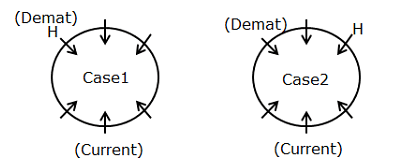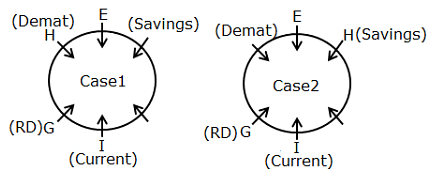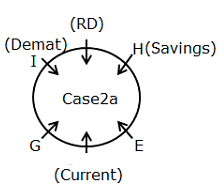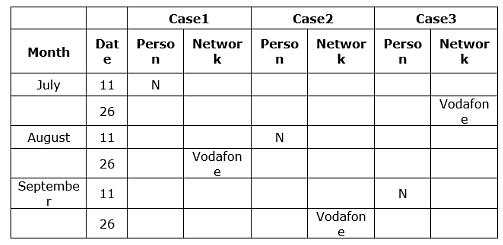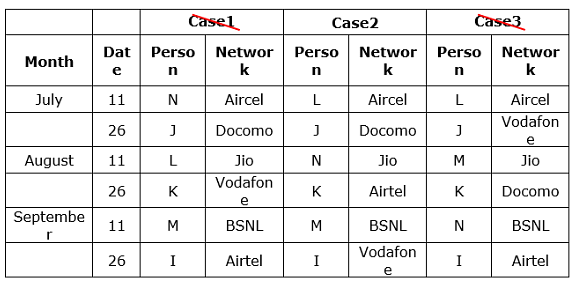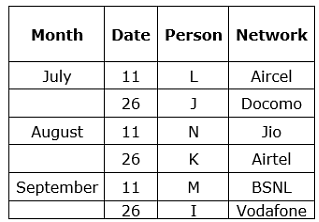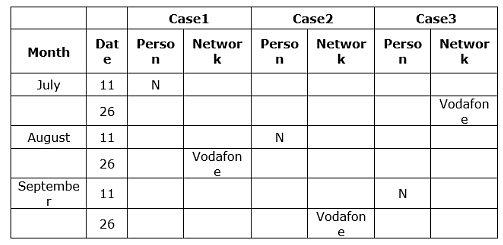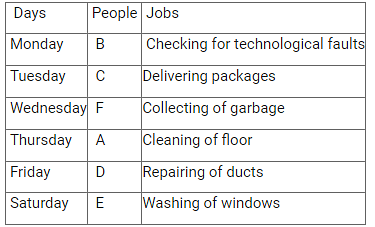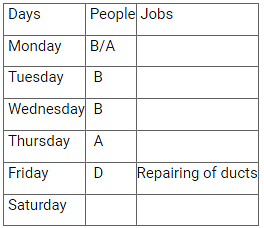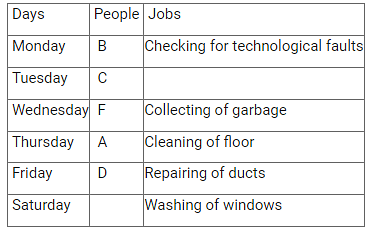IBPS RRB PO (Scale 1) Prelims Mock Test - 9 - Banking Exams MCQ
30 Questions MCQ Test - IBPS RRB PO (Scale 1) Prelims Mock Test - 9
Direction: Study the following information carefully and answer the given question.
A word and number arrangement machine when given an input line of words and numbers rearranges them following a particular hide in each step. The following is an illustration of input and rearrangement. (All the numbers are two digit numbers).
Input: 76 toy high 12 wish 98 10 flag link dig 54 87 58
Step I: dig 76 toy high 12 wish 98 flag link 54 87 58 10
Step II: flag dig 76 toy high wish 98 link 54 87 58 12 10
Step III: high flag dig 76 toy wish 98 link 87 58 54 12 10
Step IV: link high flag dig toy wish 98 87 76 58 54 12 10
Step V: toy link high flag dig wish 98 87 76 58 54 12 10
Step VI: wish toy link high flag dig 98 87 76 58 54 12 10
And Step VI is the last step of the above input, as the desired arrangement is obtained.
As per the hides followed in the above steps, find out in the question, the appropriate step for the given input. (All the numbers are two-digit numbers).
Input: height math 23 98 11 ugly and 54 owl 20 67 queen fish 32
What will be position of 98 in third step?
Direction: Study the following information carefully and answer the given question.
A word and number arrangement machine when given an input line of words and numbers rearranges them following a particular hide in each step. The following is an illustration of input and rearrangement. (All the numbers are two digit numbers).
Input: 76 toy high 12 wish 98 10 flag link dig 54 87 58
Step I: dig 76 toy high 12 wish 98 flag link 54 87 58 10
Step II: flag dig 76 toy high wish 98 link 54 87 58 12 10
Step III: high flag dig 76 toy wish 98 link 87 58 54 12 10
Step IV: link high flag dig toy wish 98 87 76 58 54 12 10
Step V: toy link high flag dig wish 98 87 76 58 54 12 10
Step VI: wish toy link high flag dig 98 87 76 58 54 12 10
And Step VI is the last step of the above input, as the desired arrangement is obtained.
As per the hides followed in the above steps, find out in the question, the appropriate step for the given input. (All the numbers are two-digit numbers).
Input: height math 23 98 11 ugly and 54 owl 20 67 queen fish 32
What is the position of “height” in step V?
| 1 Crore+ students have signed up on EduRev. Have you? Download the App |
Direction: Study the following information carefully and answer the given question.
A word and number arrangement machine when given an input line of words and numbers rearranges them following a particular hide in each step. The following is an illustration of input and rearrangement. (All the numbers are two digit numbers).
Input: 76 toy high 12 wish 98 10 flag link dig 54 87 58
Step I: dig 76 toy high 12 wish 98 flag link 54 87 58 10
Step II: flag dig 76 toy high wish 98 link 54 87 58 12 10
Step III: high flag dig 76 toy wish 98 link 87 58 54 12 10
Step IV: link high flag dig toy wish 98 87 76 58 54 12 10
Step V: toy link high flag dig wish 98 87 76 58 54 12 10
Step VI: wish toy link high flag dig 98 87 76 58 54 12 10
And Step VI is the last step of the above input, as the desired arrangement is obtained.
As per the hides followed in the above steps, find out in the question, the appropriate step for the given input. (All the numbers are two-digit numbers).
Input: height math 23 98 11 ugly and 54 owl 20 67 queen fish 32
What is the position of “fish” in last step?
Direction: Study the following information carefully and answer the given question.
A word and number arrangement machine when given an input line of words and numbers rearranges them following a particular hide in each step. The following is an illustration of input and rearrangement. (All the numbers are two digit numbers).
Input: 76 toy high 12 wish 98 10 flag link dig 54 87 58
Step I: dig 76 toy high 12 wish 98 flag link 54 87 58 10
Step II: flag dig 76 toy high wish 98 link 54 87 58 12 10
Step III: high flag dig 76 toy wish 98 link 87 58 54 12 10
Step IV: link high flag dig toy wish 98 87 76 58 54 12 10
Step V: toy link high flag dig wish 98 87 76 58 54 12 10
Step VI: wish toy link high flag dig 98 87 76 58 54 12 10
And Step VI is the last step of the above input, as the desired arrangement is obtained.
As per the hides followed in the above steps, find out in the question, the appropriate step for the given input. (All the numbers are two-digit numbers).
Input: height math 23 98 11 ugly and 54 owl 20 67 queen fish 32
Which is the last step after all arrangements?
Direction: Study the following information carefully and answer the given question.
A word and number arrangement machine when given an input line of words and numbers rearranges them following a particular hide in each step. The following is an illustration of input and rearrangement. (All the numbers are two digit numbers).
Input: 76 toy high 12 wish 98 10 flag link dig 54 87 58
Step I: dig 76 toy high 12 wish 98 flag link 54 87 58 10
Step II: flag dig 76 toy high wish 98 link 54 87 58 12 10
Step III: high flag dig 76 toy wish 98 link 87 58 54 12 10
Step IV: link high flag dig toy wish 98 87 76 58 54 12 10
Step V: toy link high flag dig wish 98 87 76 58 54 12 10
Step VI: wish toy link high flag dig 98 87 76 58 54 12 10
And Step VI is the last step of the above input, as the desired arrangement is obtained.
As per the hides followed in the above steps, find out in the question, the appropriate step for the given input. (All the numbers are two-digit numbers).
Input: height math 23 98 11 ugly and 54 owl 20 67 queen fish 32
Which would be IV step?
Study the following information carefully and answer the questions given below.
Six persons- E, F, G, H, I and J are sitting around a circular table facing the center. Each of them has different accounts viz. Savings, Current, Demat, FD, RD and NRI account. All the information is not necessarily in the same order.
One person sits between H and the one who has Current account. The one who has Demat account faces the one who sits immediate right of the one who has Current account. G sits adjacent to the one who has Demat account and sits opposite to the one who has Savings account. E sits third to the right of I. The one who has RD account sits immediate left of I. As many persons sit between J and the one who has RD account is same as between the one who has NRI account and I. F has neither NRI nor FD account.
Who among the following persons sit adjacent to the one who has NRI account?
Study the following information carefully and answer the questions given below.
Six persons- E, F, G, H, I and J are sitting around a circular table facing the center. Each of them has different accounts viz. Savings, Current, Demat, FD, RD and NRI account. All the information is not necessarily in the same order.
One person sits between H and the one who has Current account. The one who has Demat account faces the one who sits immediate right of the one who has Current account. G sits adjacent to the one who has Demat account and sits opposite to the one who has Savings account. E sits third to the right of I. The one who has RD account sits immediate left of I. As many persons sit between J and the one who has RD account is same as between the one who has NRI account and I. F has neither NRI nor FD account.
If J changed his position with F, then who among the following person sits fifth to the right of J?
Study the following information carefully and answer the questions given below.
Six persons- E, F, G, H, I and J are sitting around a circular table facing the center. Each of them has different accounts viz. Savings, Current, Demat, FD, RD and NRI account. All the information is not necessarily in the same order.
One person sits between H and the one who has Current account. The one who has Demat account faces the one who sits immediate right of the one who has Current account. G sits adjacent to the one who has Demat account and sits opposite to the one who has Savings account. E sits third to the right of I. The one who has RD account sits immediate left of I. As many persons sit between J and the one who has RD account is same as between the one who has NRI account and I. F has neither NRI nor FD account.
Who among the following person sits second to the left of F?
Study the following information carefully and answer the questions given below.
Six persons- E, F, G, H, I and J are sitting around a circular table facing the center. Each of them has different accounts viz. Savings, Current, Demat, FD, RD and NRI account. All the information is not necessarily in the same order.
One person sits between H and the one who has Current account. The one who has Demat account faces the one who sits immediate right of the one who has Current account. G sits adjacent to the one who has Demat account and sits opposite to the one who has Savings account. E sits third to the right of I. The one who has RD account sits immediate left of I. As many persons sit between J and the one who has RD account is same as between the one who has NRI account and I. F has neither NRI nor FD account.
What is the position of G with respect to I?
Study the following information carefully and answer the questions given below.
Six persons- E, F, G, H, I and J are sitting around a circular table facing the center. Each of them has different accounts viz. Savings, Current, Demat, FD, RD and NRI account. All the information is not necessarily in the same order.
One person sits between H and the one who has Current account. The one who has Demat account faces the one who sits immediate right of the one who has Current account. G sits adjacent to the one who has Demat account and sits opposite to the one who has Savings account. E sits third to the right of I. The one who has RD account sits immediate left of I. As many persons sit between J and the one who has RD account is same as between the one who has NRI account and I. F has neither NRI nor FD account.
Who among the following person has FD account?
Direction: Study the given information and answer the questions that follow.
8 members in a family - Sudha, Ravi, Shardul, Sakshi, Teju, Ramu, Deepak and Ramya went to Shimla to beat their summer heat. Family consists of 2 couples. Ramu has four children. Out of them, only one is married. The married son of Ramu has a daughter named Sakshi. Sudha is grandmother of Sakshi. Sakshi’s mother is the wife of Shardul who has an only sister named Ramya. Ravi is the younger brother of Shardul, who is not eldest. Teju is the wife of the brother of Ravi. Ramu is a male.
Who is the wife of Ramu?
Direction: Study the given information and answer the questions that follow.
8 members in a family - Sudha, Ravi, Shardul, Sakshi, Teju, Ramu, Deepak and Ramya went to Shimla to beat their summer heat. Family consists of 2 couples. Ramu has four children. Out of them, only one is married. The married son of Ramu has a daughter named Sakshi. Sudha is grandmother of Sakshi. Sakshi’s mother is the wife of Shardul who has an only sister named Ramya. Ravi is the younger brother of Shardul, who is not eldest. Teju is the wife of the brother of Ravi. Ramu is a male.
Who is Teju in this family?
Direction: Study the given information and answer the questions that follow.
8 members in a family - Sudha, Ravi, Shardul, Sakshi, Teju, Ramu, Deepak and Ramya went to Shimla to beat their summer heat. Family consists of 2 couples. Ramu has four children. Out of them, only one is married. The married son of Ramu has a daughter named Sakshi. Sudha is grandmother of Sakshi. Sakshi’s mother is the wife of Shardul who has an only sister named Ramya. Ravi is the younger brother of Shardul, who is not eldest. Teju is the wife of the brother of Ravi. Ramu is a male.
How Sakshi is related to Ravi?
Direction: Study the given information and answer the questions that follow.
8 members in a family - Sudha, Ravi, Shardul, Sakshi, Teju, Ramu, Deepak and Ramya went to Shimla to beat their summer heat. Family consists of 2 couples. Ramu has four children. Out of them, only one is married. The married son of Ramu has a daughter named Sakshi. Sudha is grandmother of Sakshi. Sakshi’s mother is the wife of Shardul who has an only sister named Ramya. Ravi is the younger brother of Shardul, who is not eldest. Teju is the wife of the brother of Ravi. Ramu is a male.
Who is the elder brother of Shardul?
Study the following information carefully and answer the questions given below.
Six persons-I, J, K, L, M and N are going to tour on two different dates either 11th or 26th in three different months viz. July, August and September of the same year. Each of them is using different mobile networks viz. Jio, Airtel, Aircel, BSNL, Docomo and Vodafone. All the information is not necessarily in the same order.
N goes on an odd-numbered date. Only two persons go between the one who uses Vodafone and N. K and J go in the same date but none of them goes in September. The one who uses Aircel goes immediately before J but not in August. As many persons go after M is same as before the one who uses Docomo. M does not go in July. Only one person goes between the one who uses Jio and BSNL. I goes immediately after the one who uses BSNL. Neither M nor L uses Jio.
Four of the following five are alike in a certain way as per the given arrangement and hence form a group. Find the one who doesn’t belong to that group.
Study the following information carefully and answer the questions given below.
Six persons-I, J, K, L, M and N are going to tour on two different dates either 11th or 26th in three different months viz. July, August and September of the same year. Each of them is using different mobile networks viz. Jio, Airtel, Aircel, BSNL, Docomo and Vodafone. All the information is not necessarily in the same order.
N goes on an odd-numbered date. Only two persons go between the one who uses Vodafone and N. K and J go in the same date but none of them goes in September. The one who uses Aircel goes immediately before J but not in August. As many persons go after M is same as before the one who uses Docomo. M does not go in July. Only one person goes between the one who uses Jio and BSNL. I goes immediately after the one who uses BSNL. Neither M nor L uses Jio.
M uses which of the following network?
Study the following information carefully and answer the questions given below.
Six persons-I, J, K, L, M and N are going to tour on two different dates either 11th or 26th in three different months viz. July, August and September of the same year. Each of them is using different mobile networks viz. Jio, Airtel, Aircel, BSNL, Docomo and Vodafone. All the information is not necessarily in the same order.
N goes on an odd-numbered date. Only two persons go between the one who uses Vodafone and N. K and J go in the same date but none of them goes in September. The one who uses Aircel goes immediately before J but not in August. As many persons go after M is same as before the one who uses Docomo. M does not go in July. Only one person goes between the one who uses Jio and BSNL. I goes immediately after the one who uses BSNL. Neither M nor L uses Jio.
Which of the following statement(s) is/are true with respect to the final arrangement?
Study the following information carefully and answer the questions given below.
Six persons-I, J, K, L, M and N are going to tour on two different dates either 11th or 26th in three different months viz. July, August and September of the same year. Each of them is using different mobile networks viz. Jio, Airtel, Aircel, BSNL, Docomo and Vodafone. All the information is not necessarily in the same order.
N goes on an odd-numbered date. Only two persons go between the one who uses Vodafone and N. K and J go in the same date but none of them goes in September. The one who uses Aircel goes immediately before J but not in August. As many persons go after M is same as before the one who uses Docomo. M does not go in July. Only one person goes between the one who uses Jio and BSNL. I goes immediately after the one who uses BSNL. Neither M nor L uses Jio.
Who among the following person uses Airtel network?
Study the following information carefully and answer the questions given below.
Six persons-I, J, K, L, M and N are going to tour on two different dates either 11th or 26th in three different months viz. July, August and September of the same year. Each of them is using different mobile networks viz. Jio, Airtel, Aircel, BSNL, Docomo and Vodafone. All the information is not necessarily in the same order.
N goes on an odd-numbered date. Only two persons go between the one who uses Vodafone and N. K and J go in the same date but none of them goes in September. The one who uses Aircel goes immediately before J but not in August. As many persons go after M is same as before the one who uses Docomo. M does not go in July. Only one person goes between the one who uses Jio and BSNL. I goes immediately after the one who uses BSNL. Neither M nor L uses Jio.
On which of the following date and month does I go to the tour?
How many pairs of digits in the number 689324 have as many numbers between them as in the series of natural numbers both in backward and forward directions?
If in the given number “9512968743”, the position of the first and the tenth digits are interchanged, the position of the second and ninth digits are interchanged and so on. Then what is the sum of the seventh digit from the right end and the sixth digit from the left end?
Which of the following symbols should be placed in the blank spaces respectively (in the same order from left to right) in order to complete the given expression in such a manner that ‘R > T’ definitely holds false?
R __ S __ Q __ P __ T
In each of the following questions, the relationship between different elements is shown in the statements followed by three conclusions. Find the conclusions which is definitely true.
Statements:
K ≤ P < H = L; R > U ≥ V; M < N = P > S ≥ R;
Conclusions:
I). N > V
II). K ≤ U
III). M < L
Directions: In the following question, assuming the given statements to be true, find which of the conclusion(s)among given conclusions is /are definitely true and then give your answers accordingly.
Statements:
C ≤ I > B = S; C ≥ L = E; K = R > E
Conclusions:
I. I > L
II. E = I
III. K ≥ L
IV. R > S
In each of the following questions, the relationship between different elements is shown in the statements followed by three conclusions. Find the conclusions which is definitely true.
Statements:
O ≤ U < Y = Q ≥ X; I > J ≥ U ≤ N; L = M ≤ J;
Conclusions:
I). N ≥ L
II). O ≤ L
III). I < X
Direction: Read the following information carefully and answer the questions that follow.
Six people visit a building on six different days of a single week other than Sunday for six different jobs. A, B, C, D, E, and F are the six people who perform Cleaning of the floor, Delivery of package, Washing of windows, Collecting garbage, Repairing ducts, and Checking for technological faults not necessarily in the same order. B visits on one of the first three days of the week and does not deliver packages. Cleaning of the floor is performed by A and visits either on Monday or Thursday. There are two people visiting between C and D. Washing of windows is done on any day after Thursday. D does repair on Friday. F doesn’t visit either on Thursday or Saturday and collects garbage. Checking for technological faults is done on Monday.
Which job is performed by B?
Direction: Read the following information carefully and answer the questions that follow.
Six people visit a building on six different days of a single week other than Sunday for six different jobs. A, B, C, D, E, and F are the six people who perform Cleaning of the floor, Delivery of package, Washing of windows, Collecting garbage, Repairing ducts, and Checking for technological faults not necessarily in the same order. B visits on one of the first three days of the week and does not deliver packages. Cleaning of the floor is performed by A and visits either on Monday or Thursday. There are two people visiting between C and D. Washing of windows is done on any day after Thursday. D does repair on Friday. F doesn’t visit either on Thursday or Saturday and collects garbage. Checking for technological faults is done on Monday.
Who visits on the last working day?
Direction: Read the following information carefully and answer the questions that follow.
Six people visit a building on six different days of a single week other than Sunday for six different jobs. A, B, C, D, E, and F are the six people who perform Cleaning of the floor, Delivery of package, Washing of windows, Collecting garbage, Repairing ducts, and Checking for technological faults not necessarily in the same order. B visits on one of the first three days of the week and does not deliver packages. Cleaning of the floor is performed by A and visits either on Monday or Thursday. There are two people visiting between C and D. Washing of windows is done on any day after Thursday. D does repair on Friday. F doesn’t visit either on Thursday or Saturday and collects garbage. Checking for technological faults is done on Monday.
Which job is performed after A leaves and before E enters the building?
Direction: Read the following information carefully and answer the questions that follow.
Six people visit a building on six different days of a single week other than Sunday for six different jobs. A, B, C, D, E, and F are the six people who perform Cleaning of the floor, Delivery of package, Washing of windows, Collecting garbage, Repairing ducts, and Checking for technological faults not necessarily in the same order. B visits on one of the first three days of the week and does not deliver packages. Cleaning of the floor is performed by A and visits either on Monday or Thursday. There are two people visiting between C and D. Washing of windows is done on any day after Thursday. D does repair on Friday. F doesn’t visit either on Thursday or Saturday and collects garbage. Checking for technological faults is done on Monday.
Who delivers the packages?
Direction: Read the following information carefully and answer the questions that follow.
Six people visit a building on six different days of a single week other than Sunday for six different jobs. A, B, C, D, E, and F are the six people who perform Cleaning of the floor, Delivery of package, Washing of windows, Collecting garbage, Repairing ducts, and Checking for technological faults not necessarily in the same order. B visits on one of the first three days of the week and does not deliver packages. Cleaning of the floor is performed by A and visits either on Monday or Thursday. There are two people visiting between C and D. Washing of windows is done on any day after Thursday. D does repair on Friday. F doesn’t visit either on Thursday or Saturday and collects garbage. Checking for technological faults is done on Monday.
Which combination of “Day-People” is not true?









